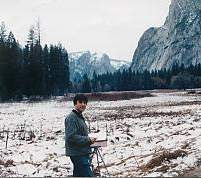

Tonight, lets continue the talk on "drawing". Let's clear the air about drawing for the sake of clarity for "drawing" is a complex critter. When we talk about drawing, it does not have to mean pencils on paper. Drawing has two definitions to the artist.
1. The correctness of objects in relationship to one another in a work of art (usually a painting or drawing). This generally refers to representational art and I'll clarify that term another time. Let us suffice to say, art that shows real things as opposed to abstract art.
2. Use of drawing instruments on paper(usually) to create a work of art or the work itself. I'm careful about not saying the word "line(s)". A drawing can be made of tones, with no apparent "lines" in it.
OK, let's handle #1. Artist's often talk about the drawing in a work of art or a painting. They might say, "The drawing is off." or "The drawing is right on." What is being judged is whether the thing represented is correct in proportion, placement and perspective as is deemed "proper". I say "proper" not "correct" as there is a difference. Some artists, like Thomas Hart Benton, intentionally bend, and distort from what would be "correct" but they are "proper" for the work and style they use. In other words, style may mean that an artist is not correct but that for the work of art in question, the drawing may be right. In the past, it was common to say,"It's out of drawing." While today someone usually would say, "The drawing's wrong in that paint."
Now for #2. A drawing is usually a work of art on paper (noun), made by use of pencils, charcoal, conte, etc... or the act of creating the work (verb). Actually we can break the use of drawing into subcategories. There are sketches, studies and cartoons that are quite often referred to as "drawings".
A sketch is usually a quickly done drawing, or painting, that is used to lay out a composition for a finished painting.
A study is usually a detailed drawing, or painting, of something that will later be part of a finished painting.
A cartoon is a drawing that is the exact size of the intended finished painting. It is used to transfer the artists idea to the canvas. It can be transferred with transfer paper or other transfer techniques. This also is a good subject for a future blog. Let me just say that traditionally this was done with a pouncing bag and a tool known as a "roulette". They are still available today and work as well as ever. Again, let me cover that in another blog.
I hope that helps with "drawing" terminology. I think most artists understand these things almost intuitively but for the novice, this may straighten out some confusion.
Let me proceed to the goal most people have with drawing. Most artists want to be able to create a painting that has "good drawing". To gain the ability to get things correct in a painting, it is advantageous to be good at #2. It's obvious that once you can create really good drawings on paper, you are going to more easily get it right in the final painting or sculpture or architecture or design. The goal is to learn to draw correctly. Next time, I'll cover one of the most common defects I see with artists learning to draw, and how to fix it.

